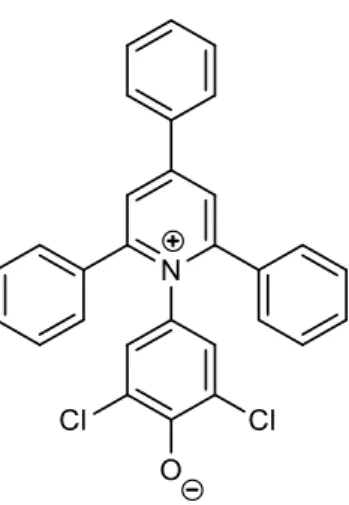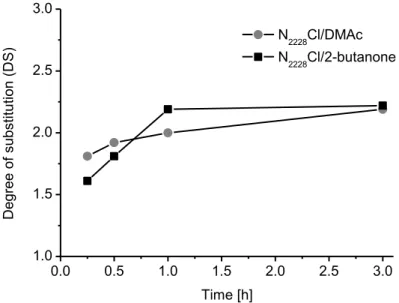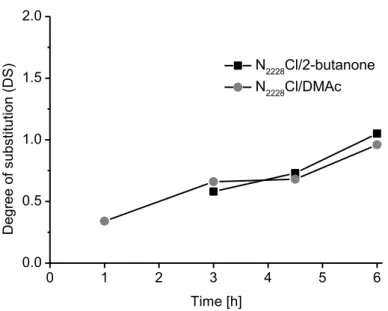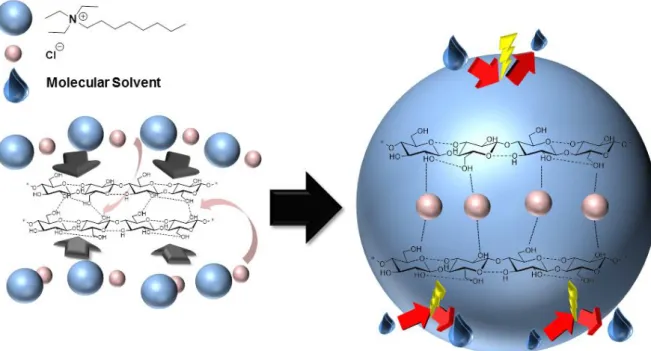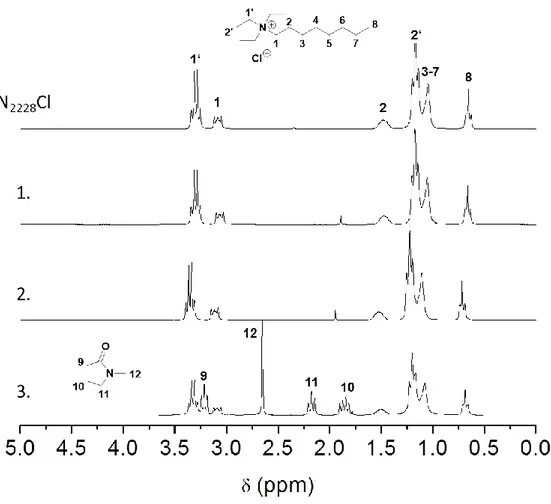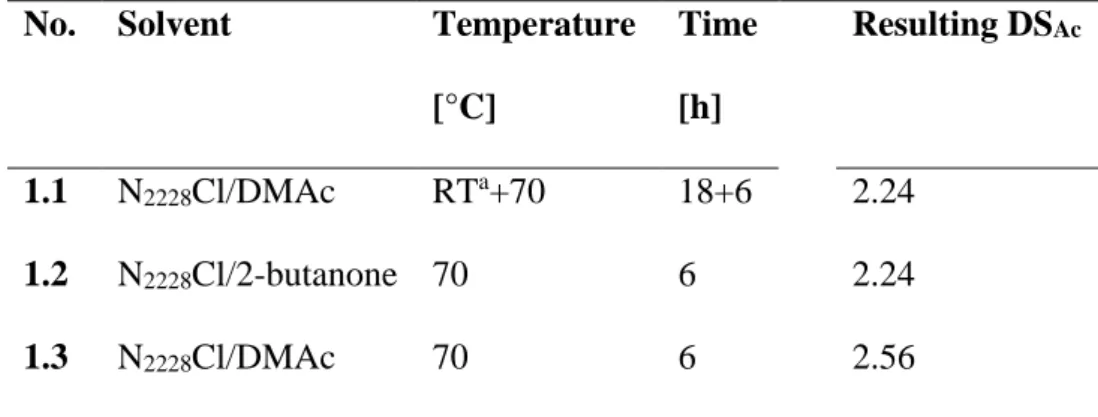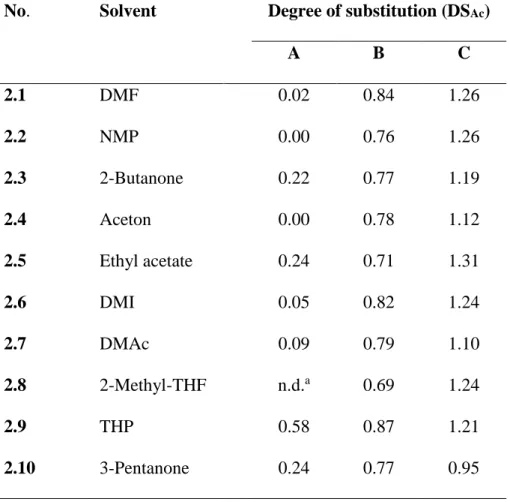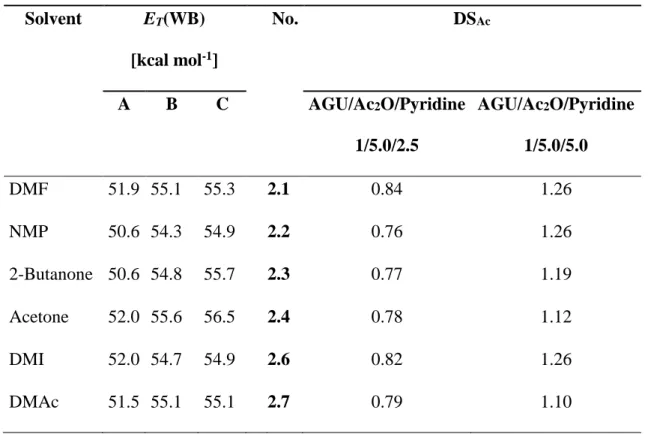Preprint
This is the submitted version of a paper published in Macromolecular materials and
engineering (Print).
Citation for the original published paper (version of record):
Achtel, C., Jedvert, K., Kostag, M., El Seoud, O A., Heinze, T. (2018)
Surprising Insensitivity of Homogeneous Acetylation of Cellulose Dissolved in Triethyl(n-octyl)ammonium Chloride/Molecular Solvent on the Solvent Polarity
Macromolecular materials and engineering (Print), 303(5)
https://doi.org/10.1002/mame.201800032
Access to the published version may require subscription. N.B. When citing this work, cite the original published paper.
Permanent link to this version:
DOI: 10.1002/marc.((insert number)) ((or ppap., mabi., macp., mame., mren., mats.)) Full Paper
Surprising insensitivity of homogeneous acetylation of cellulose dissolved in
triethyl(n-octyl)ammonium chloride/molecular solvent on the solvent
polarity
Christian Achtela, Kerstin Jedverta,b, Marc Kostagc, Omar. A. El Seoudc, Thomas Heinzea,* –––––––––
C. Achtel, Dr. K. Jedvert, Prof. T. Heinze
Centre of Excellence for Polysaccharide Research, Institute of Organic Chemistry and Macromolecular Chemistry, Friedrich Schiller University of Jena, Humboldtstraße 10, D-07743 Jena, Germany
E-mail: thomas.heinze@uni-jena.de
Permanent address for K. Jedvert: Bio-based Fibres, Swerea IVF, P.O. Box 104, SE-431 22 Mölndal, Sweden
Dr. M. Kostag, Prof. O. A. El Seoud
Institute of Chemistry, University of São Paulo, Av. Prof. Lineu Prestes 748, 05508-000 São Paulo, SP, Brazil
–––––––––
The homogeneous acetylation of microcrystalline cellulose (MCC) by acetyl chloride and acetic anhydride in triethyl(n-octyl)ammonium chloride (N2228Cl)/molecular solvents (MSs) was investigated. The reaction with both acylating agents showed the expected increase of the degree of substitution (DSAc) on reaction temperature and time. Under comparable reaction conditions, however, DSAc was surprisingly little dependent on the MS employed, although the MSs differ in polarity by 7 kcal/mol as calculated by use of solvatochromic probes. The polarities of (MCC + N2228Cl + MS) differ only by 0.8 kcal/mol. The formation a polar electrolyte sheath around cellulose chains presumably contributes to this “leveling-off” of the dependence DSAc on the polarity of the parent MS. N2228Cl recovery and recycling is feasible.
1. Introduction
Cellulose is the main component of higher plants, which makes it the most abundant biopolymer in nature. Cellulose found a broad variety of applications[1] Additionally, cellulose can be modified into a range of derivatives that are of commercial interest. Cellulose acetate (CA) with different average degree of substitution (DSAc) is used as fiber and filtration membranes. It is manufactured on a hundred kiloton scale by a heterogeneous two-step process, including complete acetylation, followed (where required) by subsequent hydrolysis to obtain product with the desired DSAc value.[2, 3] As is usual with many heterogeneous reactions, control of the regularity of the (OH → acetate) conversion in the anhydroglucose unit (AGU) and along the polymer backbone is difficult and may lead to products with irreproducible properties, hence performance. Thus, the solubility of seven commercial CAs with DSAc ≈ 2.5 (1 % ,w/w) was tested; only one sample was soluble in ethyl acetate; solubility in dichloromethane-methanol (4:1, v/v) and ethyl acetate:methanol (5.7:1, v/v) differed by factors of 7, and 11.2, respectively.[4]
A successful approach to remedy product inhomogeneity is to dissolve cellulose chemically, i.e., by forming a derivative (e.g., cellulose xanthate), or physically.[5] Physical dissolution of cellulose is a challenge due to the intricate hydrogen bond network and hydrophobic interactions within and between cellulose chains.[6, 7] Solvents for physical dissolution of the biopolymer include, e.g., LiCl in N,N-dimethylacetamide (DMAc);[8] quaternary ammonium electrolytes (QAEs) in molecular solvents, both protic (aqueous tetra-(n-butyl)phosphonium hydroxide),[9] and aprotic, e.g., tetra-(n-butyl)ammonium fluoride x 3H2O in dimethylsulfoxide (DMSO).[10, 11] A solvent for cellulose, which reached commercial success, is N-methylmorpholine-N-oxide (NMMO), used in the Lyocell process for production of cellulose textile fibers.[12] Various classes of ionic liquids (ILs) emerged as efficient cellulose solvents about fifteen years ago.[13] The use of ILs and their properties for cellulose dissolution were studied extensively.[14-16] Several studies were conducted on the acetylation of cellulose in ILs.
In 1-allyl-3-methylimidazolium chloride (AMIMCl), products with DSAc values between 0.94-2.74 could be obtained with acetic anhydride, depending on the molar ratio used.[17] Further imidazolium-based ILs were investigated for acetylation of cellulose; DSAc values of up to 3 have been accomplished in the presence of pyridine at 80°C for 2 hours.[18]
The use of ILs for cellulose dissolution and derivatization is associated with some limitations including high price, reduced mass and heat transfer due to the high viscosity of the biopolymer-IL solution, and side-reactions in particular elimination of the relatively acidic C2-H of the imidazolium ring by bases, including the IL anion.[19] Thus, there is impetus to introduce alternative cellulose solvents; of these quarternary ammonium electrolytes, (QAEs, e.g., halides and carboxylates) in MSs is the most extensively investigated example.[20, 21]
Recently, triethyl(n-octyl)ammonium chloride (N2228Cl) was found to be a solvent for cellulose. Various dipolar aprotic solvents may act as co-solvents without losing the ability to solubilize cellulose efficiently. Surprisingly, it was shown that N2228Cl can be used in combination with acetone, which otherwise is a precipitating agent (i.e., non-solvent) for cellulose; clear solutions of low viscosities were prepared.[22] A broad range of organic solvents, which can be used in combination with N2228Cl for dissolution of different cellulose, including samples of high molecular weight, were recently investigated.[23] Homogeneous acetylation of cellulose was performed in N2228Cl in combination with DMAc or acetone. Acetylation with acetyl chloride yielded CA with DSAc values comparable to CA obtained in DMAc/LiCl or 1-butyl-3-methylimidazolium chloride (BMIMCl) under comparable conditions.[24]
The aim of the present study is the investigation of the effect of the molecular solvent (MS) in combination with N2228Cl on acetylation of cellulose. A variety of MSs with different empirical polarities (as given by ET(WB) in kcal/mol, vide infra) were used while reaction time,
temperature, and reagent concentrations were kept constant. The DSAc values of the products were used as a measure for solvent effect on reactivity. Further investigations were conducted with further acylation agents under different reaction conditions. The MSs employed differ by
7 kcal/mol, hence we expected a relatively clear dependence of DSAc on ET(WB). The fact that
this was not observed, may be attributed to the similarity of “microscopic or local” polarities at the surface of the biopolymer, independent of the polarity of the MS employed. This could be due to the formation of an ionic sheath around the dissolved biopolymer chain.
2.
Experimental Section
2.1. Materials
Microcrystalline cellulose (MCC, Avicel PH-101, Fluka, DPv (ISO-5351) = 135) was applied for dissolution studies. The cellulose was dried at 100°C for 2 h prior to use. Triethyl(n-octyl)ammonium chloride (N2228Cl) was purchased from Orgentis Chemicals (m.p. 81°C) and was dried at 60°C over potassium hydroxide for 2 h prior to use. Acetone (VWR), 2-butanone (VWR), 3-pentanone (Sigma Aldrich), tetrahydropyran 99% (Acros), 2-methyltetrahydrofuran >99% (2-methyl-THF,Acros), 1,3-dimethyl-2-imidazolidinone 98% (Acros), N-methylpyrrolidone 99% (Acros), N,N-dimethylformamide 99.8% (Acros), DMAc 99.5% (Acros), pyridine >99.5 %(Acros), acetic anhydride (Fisher Scientific), and acetyl chloride (Merck), were used as received. The solvents were purified by distillation and dried over molecular sieves prior to determination of the solvatochromic parameter ET(WB). The purity
was confirmed from agreement between their experimental ET(WB) and published data.[25-27]
CA obtained from Eastman chemicals possessed a degree of substitution (DSAc) of 2.31, determined by NMR spectroscopy. 2,6-dichloro-4-(2,4,5-triphenylpyridinium-1-yl)phenolate (WB, Figure 1) was available from our previous studies and was synthesized following the procedure of Kessler et al.[28, 29]
2.2. Cellulose dissolution in MS/N2228Cl for solvatochromic measurement
A typical solution were prepared as followed: 4.67 g dry N-methylpyrrolidone 99% (Acros) (NMP), 4.56 g N2228Cl and 0.48 g MCC were transferred into a glass tube, flushed with N2 and
vigorously stirred for 2 h at 60 °C. The completed dissolution of cellulose was confirmed by means of optical microcopy (Axioskop 40 from ZEISS with a CP-Achromat objective and cross polarization).
2.3. Synthesis
Acetylation of cellulose
Depending on the MS applied, dissolution of MCC was performed in different ways, according to previously reported studies.[23] In a typical acetylation procedure, 1.58 g (15.5 mmol) acetic anhydride or 0.73 g (9.3 mmol) acetyl chloride were added to the dissolved cellulose (0.5 g, 3.1 mmol). In case of addition of pyridine, 0.61 g (7.75 mmol) or 1.23 g (15.5 mmol) of the base was added first. The resulting mixture was heated to 50 °C (acetyl chloride or acetic anhydride) or 70 °C (acetic anhydride) and reacted for 0.25, 0.5, 1, 3, 4.5 or 6 h under stirring. Isolation of the product was carried out by precipitation; the reaction mixture was poured into methanol (~200 mL, if DSAc> 1.0) or acetone (~200 mL, if DSAc< 1.0). The filtered solid was washed thoroughly two times with acetone or methanol (~150 mL), followed by three times washing and disintegration of the polymer with methanol (~150 mL) to ensure complete removal of N2228Cl and other chemicals. The product was dried at 40 °C under vacuum for 3 days.
2.4. Recycling of N2228Cl after acetylation
After acetylation, the filtrates and precipitation media were collected and concentrated by vacuum evaporation. The resulting liquid was diluted with CHCl3 (~150 mL) followed by extraction with saturated aqueous NaCl (3x ~200 mL). The organic phase was dried over magnesium sulfate and was vacuum evaporated to receive a white, hygroscopic solid. Purity of the N2228Cl obtained was characterized by NMR spectroscopy.
2.5. Characterization 2.5.1. NMR spectroscopy
The NMR spectra were measured at room temperature on a Bruker Avance 250 MHz applying 16 scans1H-NMR (250 MHz) applying ample concentration of 40 mg/mL. Samples of N2228Cl and perpropionylated CA were dissolved in CDCl3. Measurements of CA samples were conducted in DMSO-d6 after the addition of trifluoracetic acid to enable DSAc calculation. DSAc values were calculated by integrating the AGU and CH3 acetate moiety by equation (1):
DSacetate=7 ∙ ∫ CH3, acetate
3 ∙ ∫ H, AGU (1)
2.5.2. Spectrophotometric determination of ET(WB)
The final WB concentration was 2-5∙10-4 mol L-1. UV-Vis spectra of probe solutions in the different solvents showed no changes in λmax or shape of the charge-transfer band as a function of probe concentration in the range 1∙10-4 - 5∙10-4 mol L-1. This shows that there is no detectable probe aggregation under our experimental conditions. A Shimadzu UV-2550 UV-Vis spectrophotometer was used equipped with a digital thermometer (model 4000A, Yellow Springs Instruments) that measured the temperature inside the cell-holder (25 ± 0.05°C). Each spectrum was recorded 3 times at a resolution of 0.2 nm and the values of λmax were determined from the first derivative of the absorption spectrum. The uncertainty in ET(WB) is ± 0.04 kcal
mol-1 (spectral range = 400 - 700 nm).
3.
Results and Discussion
As reported in prior studies, triethyl(n-octyl)ammonium chloride (N2228Cl) is an efficient cellulose solvent.[22] In the current study, the investigations were expanded and cellulose acetate (CA) samples were prepared under different reaction conditions using a variety of molecular solvents (MS) in combination with N2228Cl. The scope of the studies was to perform a detailed examination of the influence of the binary mixtures of N2228Cl/MS on the acetylation of
cellulose. Thus, the polarity values (ET(WB)), as one of the parameters that have significant impact on the course of chemical reactions, of the solvent combinations were determined.[30]
3.1. Preparation of CA samples
Previous investigations demonstrated that N2228Cl/acetone and N2228Cl/DMAc are suitable reaction media for the homogeneous acetylation of cellulose.[24] However, solvents based on QAEs with fluoride as anions tend to lead to deacetylation under mild conditions.[31, 32] Surprisingly, the deacetylation occurred preferably at position C-2 and C-3. To exclude this side reaction using N2228Cl, different acetylation conditions were simulated, using a commercial CA possessing a DSAc value of 2.31. After the treatment, the polymer was recovered and purified to determine the DSAc (Table 1).
The results obtained disproved any deacetylation by the use of N2228Cl as solvent under the applied reaction conditions. Neither the treatment of CA in N2228Cl at elevated temperatures of 70 °C nor the imitation of the prior dissolution process had an influence on the DSAc. The deviation of the final DSAc values belongs to measurement uncertainty.
Required DSAc values of the prepared CA should reach a value between 1.0 and 1.5 to have suitable prerequisites for the later calculations. Therefore, different reaction conditions were investigated, varying reaction time, reaction temperature and acetylation agent (Figure 2). N2228Cl was combined with different MS, which may affect the final polarity of the solvent composition. The solvents chosen were DMF, NMP, 2-butanone, acetone, ethyl acetate, DMI, DMAc, 2-methyl-THF, THP, and 3-pentanone. In previous studies, it was demonstrated that cellulose is soluble in all of these N2228Cl/MS mixtures following a certain dissolution protocol and there are included different types of solvents.[23]
In order to find the optimum conditions to achieve DSAc values between 1.0 and 1.5, cellulose was converted with acetic anhydride (Ac2O) or acetyl chloride at different reaction time. Prior
studies demonstrated already that reactions in ILs employing acetyl chloride can achieve high DSAc values between 2.5 and 3.0 within 2 h at 80 °C.[18] To slow down the conversion, reactions were carried out at 50 °C within 0.25 h to 3 h applying N2228Cl/2-butanone or N2228Cl/DMAc as reaction media. Whereby, N2228Cl/2-butanone is representing a solvent system that is uncommon for cellulose chemistry, and the DMAc based solvent belongs to the solvents normally applied for polysaccharides. The DSAc values of CA obtained depending on reaction time are presented in Figure 3.
In general, the DSAc values for the different reaction times were quite similar. As illustrated in
Figure 3, a reaction time of 0.25 h led to DSAc values of 1.68 (N2228Cl/2-butanone) or 1.81 (N2228Cl/ DMAc). Increasing the reaction time to 3 h resulted in final DSAc of 2.22 and 2.19 applying N2228Cl/2-butanone and N2228Cl/DMAc, respectively. Regarding the progress of the acetylation, both curves show a fast increase in DSAc up to a reaction time of one hour (DSAc= 2.0 and 2.19), afterwards the values leveled off and approached their final values (DSAc= 2.19 and 2.22).Thus, prolonging the reaction time would not result in higher DSAc. Thereby, the reactions performed in N2228Cl/2-butanone showed a stronger increase in DSAc depending on the reaction time, whereas, the reaction in N2228Cl/DMAc possessed a higher DSAc at short reaction times.
In the next set of experiments, the acetylation was carried out with acetic anhydride. As already demonstrated, the acetylation with acetic anhydride is less efficient compared to those applying acetyl chloride.[24] Thus, a molar ratio AGU/Ac
2O of 1/5 and a reaction temperature of 70 °C were applied. Since a lower reactivity can be expected for acetic anhydride, the reaction time ranged from 1 to 6 h (Figure 4).
As expected, in case of acetic anhydride as acetylating agent, the resulting DSAc values were significantly lower compared to the reactions with acetyl chloride. After 6 h, the DSAc values achieved were 1.05 (N2228Cl/ 2-butanone) and 0.96 (N2228Cl/ DMAc). As summarized in Figure
the DSAc increases almost linearly. Thus, it was expected that longer reaction times would further increase the DSAc value. Drastic changes of the DSAc depending on the solvent system used were not observed (1.05 and 0.96). Again, both reaction media led to products of similar DSAc values.
Since the esterification with acetyl chloride gave products of high DSAc values after 1 h, the reactions using the entire solvent mixtures (N2228Cl/MS) were carried out with acetic anhydride. Thus, the adjustments of the reaction conditions in order to control the DSAc values were easier to carry out. In order to be able to include the volatile acetone as one of the MS, the reactions were performed at 50 °C for 6 h applying acetic anhydride. Experiments were also performed both with and without pyridine as base (Table 2).
As summarized in Table 2, the reaction of cellulose with acetic anhydride exhibited very low conversion. Addition of pyridine to the reaction mixture caused a significant enhancement of the reaction efficiency. The DSAc values obtained ranged from 0.69 to 0.87 (2.1B-2.10B). The molar ratio of AGU/Ac2O/pyridine of 1/5/2.5 led to in situ formation of acetylpyridinium ion, which renders a higher reactivity compared to acetic anhydride.[33] Consequently, further increase of the pyridine amount gave CA with DSAc values between 0.95 and 1.31
(2.1C-2.10C). Thus, the reactivity was mainly controlled by the acetylpyridinium ions formed. On the contrary, the acetylation of cellulose with acetic anhydride without a base was not sufficient under the conditions investigated. It was also noticeable that the DSAc values were independent of the N2228Cl/MS applied, as they only varied in a narrow range for the solvent systems investigated. An exception was the reaction performed in N2228Cl/3-pentanone with an equimolar ratio of Ac2O and pyridine, which gave a CA of comparably low DSAc (2.10). This low DSAc was attributed to low solubility of MCC in that mixture, thus, diminishing the reactivity.
Unexpectedly, the DSAc values of the CA samples possessed comparable values applying the same reaction conditions, however, applying different MS (Table 2). Thus, it was of interest to study the solvent polarity. Because of the acidic nature of N2228Cl, the solvent polarity parameter was determined employing ET(WB). For the measurements, a 1/1 ratio by weight was applied for the mixtures of N2228Cl/MS. The corresponding cellulose solutions were obtained by adding 5 wt% MCC to N2228Cl/MS and subsequent stirring for at least 2 h at 60 °C; i.e., the final composition of the solution N2228Cl/MS/cellulose was 9.5/9.5/1 by weight. The ET(WB) values measured for the MS, N2228Cl/MS, and for the solution of cellulose in N2228Cl/MS are presented in Table 3, as well as the DSAc values of the corresponding CA discussed in the previous section.
For the reactions, relatively polar and strongly dipolar aprotic solvents were used. DMAc and DMF are commonly employed in polysaccharide chemistry and in particular in combination with ILs, too.[14, 34] The dependence of DSAc of the obtained esters on the nature of the MS employed was probed, as given by their empirical solvent polarity parameter ET(WB). This
correlation is valid, because we showed that the reaction product (CA) was stable under the experimental conditions (see 3.1). Surprisingly, the results for acetylation in 10 MS showed little dependence of DSAc on ET(WB) of the MS (Table 3). Additional ET(WB) measurements
showed that dissolution of QAE in MS resulted in a noticeable increase of medium polarity, by 3.7 ± 0.5 kcal/mol, excluding DMI. Dissolution of MCC in these N2228Cl/MS mixtures resulted only in a small increase of ET(WB) relative to the MS. The final polarity values of
N2228Cl/MS/cellulose were 55.3 ± 0.4 kcal/mol, excluding acetone. That is, the increase in ET(WB) of the final solutions (relative to MS) are essentially due to interactions (electrostatic
and hydrogen bonding) of the N2228+ and to a lesser degree of the hydroxyl groups of the AGU with the phenolate oxygen of WB. The unexpected relative insensitivity of DSAc to the nature of the MS showed that N2228Cl dominated the polarity of the final solution, not that of the pure solvents that controlled the reaction. Apparently, the relatively high molality of N2228Cl had a
“leveling-off” effect on medium polarity. Hence, the nature of the MS had only a minimal influence on the acetylation reaction and on the final DSAc. Furthermore, the high N2228Cl concentration can lead to encapsulation of the cellulose chains that is the anion interacts with the hydroxyl groups of the polymer backbone, whereas the cation forms the sheath (Figure 5). Due to this sheath the polarities at reaction site in different MS did not differ appreciably, thus, a slight effect of MS on the DSAc obtained can be observed.Moreover, this would also be an explanation for the solubility of cellulose in MS of low polarity combined with N2228Cl, although the employed MS do not swell cellulose.
3.3. Recovery of N2228Cl after the acetylation
In order to examine the possibility to reuse the N2228Cl, the filtrates and washings after acetylation were collected and purified to recover the QAE. The products obtained were studied by 1H-NMR spectroscopy to determine the purity of the salt (Figure 6).
Figure 6 illustrates that N2228Cl was recovered successfully depending on the MS applied, for the dissolution of cellulose. In the 1H-NMR spectra different chemical shifts of the hydrogen atoms were observed that could be attributed to the different N2228Cl concentrations used for the NMR spectroscopic measurements. Thus, anion coordination differed in between the samples, which led to varying electron densities at the respective hydrogen atoms.[35] The spectrum at the top represents pure N2228Cl. The salts, which were recovered from mixtures containing N2228Cl/2-butanone or N2228Cl/acetone, enabled the complete purification of N2228Cl after the reaction (Figure 6.1 and 6.2). The signals in the 1H-NMR spectra can be clearly assigned to N2228Cl and remaining water, the latter was caused by the hygroscopic nature of the salt. The recovery process yielded 93 % (N2228Cl/2-butanone) and 91 % (N2228Cl/acetone) of the N2228Cl originally applied. However, the demonstrated spectrum in Figure 6.3 contained some impurities that could be assigned to the MS NMP employed. The same observations occurred for other organic solvents possessing a comparable high boiling point, i.e., DMF, DMAc, and
DMI. Whereas solvents like acetone or 2-butanone were able to be removed by final vacuum evaporation, solvents with higher boiling point remained in the product recovered. Remaining MS in the product was responsible for preventing the crystallization of the salt. Further investigations will cover that issue by aiming an optimization of extraction of N2228Cl.
The successful recovery of N2228Cl from mixtures with acetone is even more interesting considering the fact that products containing low DSAc values (DSAc<1.0) were likewise precipitated in acetone. This provides new opportunities in the process flow of CA manufacture. The utilization of acetone as solvent as well as precipitation agent, and the complete recovery of N2228Cl, could facilitate selected working steps and recycling processes, leading to a potentially cheaper CA production.
4.
Conclusions
The studies presented were carried out to determine the dependence of the DSAc on the polarity value (ET(WB)) of the N2228Cl/MS mixture applied. The results demonstrated that the solvent mixtures investigated possessed similar ET(WB) values just differing in approximately 1.5 kcal/mol. Accordingly, the DSAc achieved under the corresponding reaction conditions, showed similar values. As discussed, the DSAc-values were mainly affected by the reaction conditions and acetylation agents selected.
Further studies will prove if MS, which are proven non-solvents for MCC in combination with N2228Cl, also show comparable polarity values and what DSAc values can be achieved in those heterogeneous mixtures. Moreover, it is necessary to decrease the concentration of N2228Cl in these mixtures, since a “leveling-off” effect of the electrolyte on the polarity values is expected. It is also expected that the N2228Cl covers the cellulose and isolate it from its environment and, therefore, makes it impervious to changes of MS. Another approach could be the utilization of another dye system, which is more sensitive for determination of polarity values, independent of the concentration of N2228Cl.
Finally, successfully electrolyte recovery was presented for N2228Cl/MS mixtures employing a MS with low boiling point. These solvents could be fully separated from N2228Cl by extraction and evaporation after the acetylation reaction. This is an interesting result, considering the fact that CA with low DSAc <1.0 can be dissolved and precipitated in acetone. The same purification procedure did not work for solvents with higher boiling point, leading to products that still contained some impurities of MS. Hence, for MS like DMF, DMI, DMAc, and NMP further recovery investigations need to be done.
Acknowledgements:
KJ gratefully acknowledges the Swedish Research Council Formas for financial support.
Keywords:
Cellulose acetate, solvatochromism, solvent polarity, triethyl(n-octyl)ammonium chloride, homogeneous acetylation, recycling
0.0 0.5 1.0 1.5 2.0 2.5 3.0 1.0 1.5 2.0 2.5 3.0 D egree of s ubs tit ut ion (D S) Time [h] N2228Cl/DMAc N2228Cl/2-butanone
Figure 3: Degree of substitution of cellulose acetate (DSAc) synthesized in N2228Cl/DMAc and N2228Cl/2-butanone (molar ratio AGU/acetyl chloride = 1/3, 50 °C) in dependence of the different reaction times applied.
0 1 2 3 4 5 6 0.0 0.5 1.0 1.5 2.0 D egree of s ubs tit ut ion (D S) Time [h] N2228Cl/2-butanone N2228Cl/DMAc
Figure 4: Degree of substitution of cellulose acetate (DSAc) synthesized in N2228Cl/DMAc and N2228Cl/2-butanone (molar ratio AGU/acetic acid anhydride = 1/5, 70 °C) in dependence of the different reaction times applied.
Figure 5: Potential sheath formation during cellulose dissolution. The chloride anions (bright red) interact with the hydroxyl units, the cations (bright blue) build the sheath and “isolate” the cellulose from the molecular solvent (dark blue droplet)
Figure 6: 1H-NMR spectra recorded in CDCl3 of neat N2228Cl (top) and recovered N2228Cl after acetylation from solvent mixtures N2228Cl/2-butanone (1.), N2228Cl/acetone (2.) and N2228Cl/NMP (3.)
Table 1: Results of deacetylation investigations applying a CA (degree of substitution, DSAc = 2.31) under reaction conditions applied for acetylation
No. Solvent Temperature Time Resulting DSAc
[°C] [h]
1.1 N2228Cl/DMAc RTa+70 18+6 2.24
1.2 N2228Cl/2-butanone 70 6 2.24
1.3 N2228Cl/DMAc 70 6 2.56
Table 2: Conditions for and results of the acetylation of cellulose applying different molar ratio of anhydroglucose unit (AGU)/Ac2O of 1/5 (A), AGU/Ac2O/pyridine of 1/5/2.5 (B), and AGU/Ac2O/pyridine of 1/5/5 (C) in N2228Cl/MS, 50°C 6 h
No. Solvent Degree of substitution (DSAc)
A B C 2.1 DMF 0.02 0.84 1.26 2.2 NMP 0.00 0.76 1.26 2.3 2-Butanone 0.22 0.77 1.19 2.4 Aceton 0.00 0.78 1.12 2.5 Ethyl acetate 0.24 0.71 1.31 2.6 DMI 0.05 0.82 1.24 2.7 DMAc 0.09 0.79 1.10 2.8 2-Methyl-THF n.d.a 0.69 1.24 2.9 THP 0.58 0.87 1.21 2.10 3-Pentanone 0.24 0.77 0.95 a-not determined
Table 3: Results of the solvatochromic investigations of different organic solvents (A), organic solvent/N2228Cl (B), and organic solvent/N2228Cl/cellulose (C) and degree of substitution (DSAc) of cellulose acetates prepared
Solvent ET(WB) [kcal mol-1] No. DSAc A B C AGU/Ac2O/Pyridine 1/5.0/2.5 AGU/Ac2O/Pyridine 1/5.0/5.0 DMF 51.9 55.1 55.3 2.1 0.84 1.26 NMP 50.6 54.3 54.9 2.2 0.76 1.26 2-Butanone 50.6 54.8 55.7 2.3 0.77 1.19 Acetone 52.0 55.6 56.5 2.4 0.78 1.12 DMI 52.0 54.7 54.9 2.6 0.82 1.26 DMAc 51.5 55.1 55.1 2.7 0.79 1.10
Homogeneous acetylation of cellulose is investigated in different N2228Cl/molecular solvens. In order to determine if there is a dependency of the polarity of the solvent applied and the achieved DSAc, the ET(WB) value of the solvent mixtures is examined. The results lead to
the assumption that due to high N2228Cl concentration cellulose is covered by a sheat of N2228Cl, isolating the cellulose.
Christian Achtela, Kerstin Jedverta,b, Marc Kostagc, Omar. A. El Seoudc, Thomas Heinzea,* Influence of the empirical polarity of the molecular solvent on cellulose acetylation in the presence of triethyl(n-octyl)ammonium chloride
References
[1] T. Heinze, Liebert, T., in Polymer Science: A Comprehensive Reference, Vol. 10 (Ed.: E. B. V.), Amsterdam, 2012, pp. 83-152.
[2] O. A. El Seoud, H. Nawaz, E. P. G. Areas, Molecules 2013, 18, 1270-1313. [3] P. Rustemeyer, Macromol. Symp. 2004, 208, 1-6.
[4] S. Fischer, K. Thümmler, B. Volkert, K. Hettrich, I. Schmidt, K. Fischer, Macromol. Symp. 2008, 262, 89-96.
[5] D. Klemm, B. Philipp, T. Heinze, U. Heinze, W. Wagenknecht, Comprehensive Cellulose Chemistry, Wiley-VCH Verlag GmbH & Co. KGaA, 1998.
[6] C. Olsson, G. Westman, in Cellulose - Fundamental Aspects (Eds.: T. v. d. Ven, L. Godbout), InTech, Rijeka, 2013, chpter 6.
[7] T. Liebert, in Cellulose Solvents: For Analysis, Shaping and Chemical Modification (Eds.: T. Heinze, T. Liebert, K. J. Edgar), American Chemical Society, Washington DC, 2009, pp. 3-54.
[8] T. R. Dawsey, C. L. Mccormick, J. Macromol. Sci., Rev. Macromol. Chem. Phys. 1990, 30, 405-440.
[9] M. Abe, Y. Fukaya, H. Ohno, Chem. Commun. 2012, 48, 1808-1810.
[10] T. Heinze, R. Dicke, A. Koschella, A. H. Kull, E. A. Klohr, W. Koch, Macromol. Chem. Phys. 2000, 201, 627-631.
[11] G. T. Ciacco, T. F. Liebert, E. Frollini, T. J. Heinze, Cellulose 2003, 10, 125-132. [12] H. P. Fink, P. Weigel, H. J. Purz, J. Ganster, Prog. Polym. Sci. 2001, 26, 1473-1524. [13] R. P. Swatloski, S. K. Spear, J. D. Holbrey, R. D. Rogers, J. Am. Chem. Soc. 2002, 124,
4974-4975.
[14] M. Gericke, T. Liebert, O. A. El Seoud, T. Heinze, Macromol. Mater. Eng. 2011, 296, 483-493.
[15] M. Gericke, P. Fardim, T. Heinze, Molecules 2012, 17, 7458-7502.
[16] M. Isik, H. Sardon, D. Mecerreyes, Int. J. Mol. Sci. 2014, 15, 11922-11940.
[17] J. Wu, J. Zhang, H. Zhang, J. S. He, Q. Ren, M. Guo, Biomacromolecules 2004, 5, 266-268.
[18] S. Barthel, T. Heinze, Green Chem. 2006, 8, 301-306.
[19] G. Ebner, S. Schiehser, A. Potthast, T. Rosenau, Tetrahedr. Lett. 2008, 49, 7322-7324. [20] S. Kohler, T. Heinze, Macromol. Biosci. 2007, 7, 307-314.
[21] A. Idstrom, L. Gentile, M. Gubitosi, C. Olsson, B. Stenqvist, M. Lund, K. E. Bergquist, U. Olsson, T. Kohnke, E. Bialik, Cellulose 2017, 24, 3645-3657.
[22] M. Kostag, T. Liebert, O. A. El Seoud, T. Heinze, Macromol. Rapid Commun. 2013, 34, 1580-1584.
[23] C. Achtel, K. Jedvert, B. Kosan, O. A. E. Seoud, T. Heinze, Macromol. Chem. Phys. 2017, 218, 1700208-n/a.
[24] C. Achtel, T. Heinze, Macromol. Chem. Phys. 2016, 217, 2041-2048. [25] C. Reichardt, Pure Appl. Chem. 2004, 76, 1903-1919.
[26] C. Reichardt, Pure Appl. Chem. 2008, 80, 1415-1432.
[27] C. Reichardt, T. Welton, in Solvents and Solvent Effects in Organic Chemistry, Wiley-VCH Verlag GmbH & Co. KGaA, 2010, pp. 425-508.
[28] J. C. de Jesus, P. A. R. Pires, R. Mustafa, N. Riaz, O. A. Seoud, RSC Adv. 2017, 7, 15952-15963.
[29] M. A. Kessler, O. S. Wolfbeis, Chem. Phys. Lipids 1989, 50, 51-56.
[30] C. Reichardt, T. Welton, In Solvents and Solvent Effects in Organic Chemistry, 4th ed., Wiley-VCH Verlag GmbH & Co. KGaA, Weinheim, 2010.
[31] X. Zheng, R. D. Gandour, K. J. Edgar, Carbohydr. Polym. 2013, 98, 692-698. [32] X. Zheng, R. D. Gandour, K. J. Edgar, Carbohydr. Polym. 2014, 111, 25-32.
[33] A. R. Fersht, W. P. Jencks, J. Am. Chem. Soc. 1970, 92, 5432-5442.
[34] O. Jogunola, V. Eta, M. Hedenstrom, O. Sundman, T. Salmi, J. P. Mikkola, Carbohydr. Polym. 2016, 135, 341-348.
